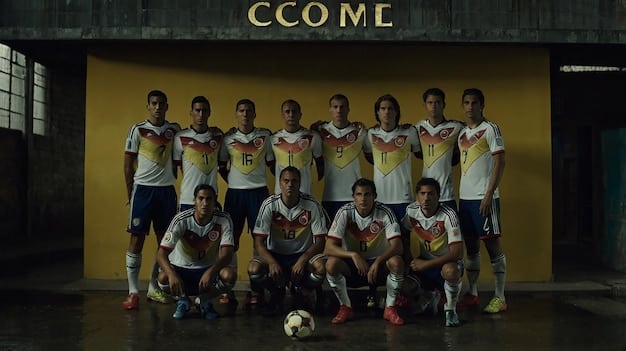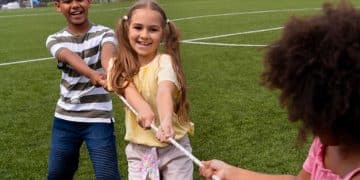FIFA’s Fight Against Racism: Impact on US Soccer Culture

FIFA’s Efforts to Combat Racism: Examining the Impact on US Soccer Culture reveals the governing body’s strategies to tackle discrimination in soccer and its subsequent influence on the sport within the United States.
Soccer, known globally as football, is a sport that unites people from diverse backgrounds. However, like many areas of society, it has faced challenges with racism. FIFA’s Efforts to Combat Racism: Examining the Impact on US Soccer Culture is crucial, particularly as the sport continues to grow in popularity in the United States. What measures has FIFA implemented, and how effective have they been in shaping a more inclusive environment within US soccer?
Understanding FIFA’s Anti-Racism Initiatives
FIFA, as the international governing body of soccer, has a responsibility to promote equality and combat discrimination within the sport. Understanding the scope and nature of FIFA’s anti-racism initiatives is the first step in gauging its impact on US soccer culture.
Key Anti-Racism Campaigns and Policies
FIFA has launched several campaigns and implemented policies aimed at eradicating racism. These initiatives often involve educational programs, stricter penalties for discriminatory behavior, and support for diversity and inclusion.
- Zero Tolerance Campaign: This campaign emphasizes FIFA’s commitment to eliminating racism from soccer.
- Monitoring and Sanctions: FIFA monitors matches for racist behavior and imposes sanctions on individuals and teams found guilty.
- Diversity Programs: FIFA supports programs that promote diversity and inclusion at all levels of the sport.
FIFA’s commitment to combating racism extends beyond mere statements, involving tangible actions and policies meant to foster a more inclusive environment for players and fans alike.

The Reach of FIFA’s Directives into US Soccer
The United States Soccer Federation (USSF) is responsible for overseeing soccer in the US. But how deeply do FIFA’s anti-racism directives penetrate US soccer culture, and what measures are taken to ensure compliance?
Adoption and Implementation by USSF
USSF integrates FIFA’s anti-racism policies into its own regulations and programs. This includes implementing codes of conduct, providing anti-discrimination training, and addressing incidents of racism within US soccer leagues.
USSF takes FIFA’s directives seriously, adapting them to the specific context of US soccer to promote a culture of inclusivity. These adaptations aim to ensure that FIFA’s broad policies are effectively applied at the grassroots and professional levels.
Examining the Impact on US Soccer Culture
What is the practical impact of FIFA’s Efforts to Combat Racism: Examining the Impact on US Soccer Culture? It’s crucial to evaluate how these initiatives translate into tangible changes on and off the field within the United States.
Positive Changes Observed
Progress has been made, with increased awareness of racism and a greater emphasis on inclusivity within US soccer. Teams and organizations have adopted anti-discrimination policies, and there’s a growing commitment to diversity.
While challenges persist, the increased focus on anti-racism has led to a more inclusive environment, impacting player experiences, fan engagement, and overall soccer culture in the US.

Challenges and Criticisms
Despite the progress, challenges remain in the ongoing effort to combat racism in US soccer. FIFA and USSF face criticisms regarding the effectiveness and enforcement of their anti-racism measures.
Areas Needing Improvement
Some argue that FIFA’s sanctions are not consistently applied or are too lenient. Others criticize the lack of diversity in leadership positions within soccer organizations.
Addressing these shortcomings is essential for sustaining progress and ensuring that anti-racism efforts are genuinely impactful and transformative within US soccer.
Case Studies: Impact in Youth and Professional Levels
Examining case studies from both youth and professional levels provides a clearer understanding of how FIFA’s Efforts to Combat Racism: Examining the Impact on US Soccer Culture play out in practice. These examples can illustrate both successes and areas needing improvement.
Examples of Success and Failure
Some youth soccer leagues have successfully implemented anti-racism training for coaches and players. However, incidents of racism still occur, highlighting the need for ongoing vigilance and education.
- Successful Anti-Racism Training: Youth leagues have seen positive changes through mandatory training programs that promote inclusivity and respect.
- Incident Reporting and Response: Improved systems for reporting and addressing racist incidents are vital for effectively combating discrimination.
- Community Engagement: Initiatives that engage local communities can foster a sense of belonging and shared responsibility in creating an inclusive soccer environment.
By learning from both successes and failures, US soccer can refine its approach to combating racism and create a more welcoming environment for all.
The Future of Anti-Racism in US Soccer
The fight against racism in soccer is an ongoing process. The future success of FIFA’s Efforts to Combat Racism: Examining the Impact on US Soccer Culture depends on sustained commitment, continuous improvement, and collaborative efforts from all stakeholders.
Strategies for Sustained Progress
Continued investment in education, stricter enforcement of sanctions, and greater diversity in leadership are crucial for creating lasting change. FIFA and USSF must work together to ensure that anti-racism efforts remain a top priority.
| Key Point | Brief Description |
|---|---|
| ⚽ Anti-Racism Initiatives | FIFA implements campaigns and policies to combat racism in soccer worldwide. |
| 🤝 USSF Adoption | The US Soccer Federation integrates FIFA’s directives into its own regulations. |
| 🌱 Youth & Pro Impact | Case studies reveal successes and ongoing challenges at various levels. |
| 🔮 Future Strategies | Sustained commitment and collaboration are crucial for future progress. |
Frequently Asked Questions
FIFA has implemented campaigns, stricter penalties for discriminatory behavior, and support for diversity programs. These efforts aim to create a more inclusive environment.
The USSF integrates FIFA’s policies into its regulations, provides anti-discrimination training, and addresses incidents of racism within US soccer leagues.
Challenges include inconsistent application of sanctions, lack of diversity in leadership, and the persistence of racist incidents at youth and professional levels.
Yes, some youth leagues have implemented anti-racism training for coaches and players, promoting inclusivity and respect within their programs.
The long-term goal is to create a sustainable culture of inclusivity and respect within soccer, ensuring that the sport remains welcoming and accessible to all participants.
Conclusion
In conclusion, FIFA’s Efforts to Combat Racism: Examining the Impact on US Soccer Culture are vital for promoting equality and inclusivity within the sport. While progress has been made, sustained commitment and continuous improvement are necessary to address ongoing challenges and create a truly welcoming environment for all players and fans in the United States.





